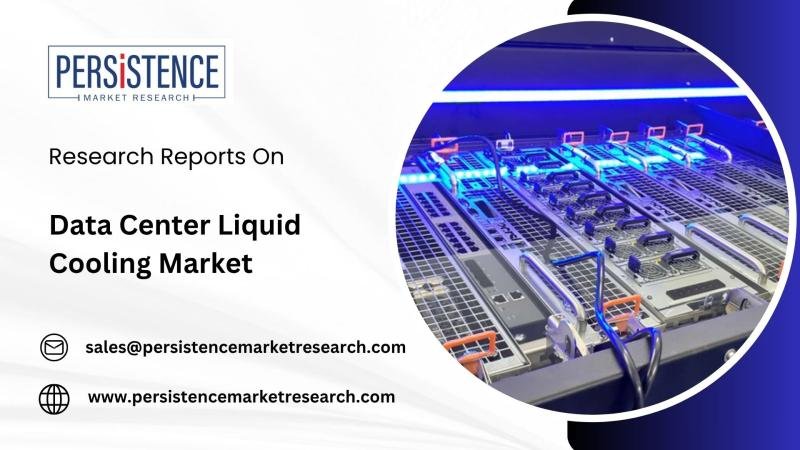Market Overview
The global Data Center Liquid Cooling Market is rapidly evolving as enterprises strive for higher energy efficiency, performance, and sustainability in data operations. Valued at US$ 4.1 billion in 2024, the market is forecasted to surge to US$ 19.4 billion by 2031, reflecting an impressive CAGR of 24.6% from 2024 to 2031. The increasing reliance on High-Performance Computing (HPC), AI, cloud computing, and big data analytics has intensified the need for thermal management solutions, making liquid cooling the preferred choice over traditional air-cooling systems.
Among the key segments, the solution component dominates, expected to capture around 74% market share in 2024 due to the demand for fully integrated and scalable cooling systems. North America leads the market geographically, with a projected CAGR of 11.5% through 2031, fueled by widespread hyperscale data center adoption, stricter regulatory standards for energy efficiency, and growing investments in AI infrastructure.
Elevate your business strategy with comprehensive market data. Request a sample report now: https://www.persistencemarketresearch.com/samples/13330
🔹 Key Highlights from the Report
• Data center liquid cooling systems are reducing cooling energy consumption by up to 40%.
• Hyperscale data centers are key adopters of liquid cooling solutions to handle high-density computing.
• AI, big data, and machine learning are major demand drivers for advanced cooling technologies.
• North America dominates due to stringent energy regulations and rising demand for HPC applications.
• The solution segment will account for a 74% market share in 2024.
• Liquid cooling is gaining traction in edge data centers to manage heat in distributed IT environments.
Market Segmentation
The data center liquid cooling market is segmented by component, with two primary categories: solutions and services. The solution segment, comprising direct-to-chip cooling and immersion cooling systems, leads the market. This dominance is attributed to the increasing preference for integrated cooling systems that offer greater thermal efficiency and ease of deployment. Services include design, installation, and maintenance, essential for ensuring the performance and longevity of liquid cooling systems.
By application, the market is segmented into hyperscale, colocation, and edge data centers. Hyperscale data centers hold a major share due to their large-scale server deployments that require high-capacity cooling systems. On the other hand, edge data centers-smaller setups closer to end-users-are increasingly adopting liquid cooling to maintain operational reliability in constrained spaces.
Regional Insights
North America remains at the forefront, driven by the United States’ high demand for HPC, strong technological infrastructure, and stringent energy efficiency mandates. Major companies are also heavily investing in liquid-cooled Azure and AWS data centers.
Asia Pacific is emerging as a fast-growing region, fueled by rapid data center construction in China, India, and Southeast Asia. The push toward digitalization, cloud migration, and smart city development in these economies is supporting robust market growth.
Market Drivers
One of the strongest drivers is the rising need for energy-efficient cooling solutions in response to regulatory pressure and environmental sustainability goals. Liquid cooling is up to 3,000 times more efficient than air in terms of heat transfer, making it indispensable for dense computing workloads in AI, ML, and HPC applications. The exponential growth of data and demand for real-time processing are further accelerating adoption.
Market Restraints
Despite its advantages, high initial investment costs and infrastructure challenges are major restraints. Liquid cooling systems require specific infrastructure upgrades, such as leak-proof designs and specialized monitoring tools. Moreover, there is a lack of standardization in installation practices, which can limit large-scale deployments, especially in existing or retrofitted data centers.
Market Opportunities
With sustainability becoming a top priority, green data centers are incorporating liquid cooling systems to reduce energy consumption and carbon footprint. In addition, the increasing deployment of edge data centers and micro data centers opens up new avenues. These smaller data centers need highly efficient and compact cooling solutions, where liquid cooling fits perfectly. Furthermore, technological innovations in immersion and two-phase cooling systems are creating newer, more efficient product variants for the market.
✅ Reasons to Buy the Report
✔ Gain access to an in-depth market forecast up to 2031 backed by data-driven insights.
✔ Understand the technological trends reshaping the future of data center cooling.
✔ Identify key investment opportunities in high-growth regions and segments.
✔ Benchmark against leading market players and learn from their strategic moves.
✔ Make informed decisions with detailed segmentation and competitive analysis.
# Frequently Asked Questions (FAQs)
#1. How Big is the Data Center Liquid Cooling Market in 2024?
#2. What is the Projected Growth Rate of the Market through 2031?
#3. Who are the Key Players in the Global Market for Data Center Liquid Cooling?
#4. What is the Market Forecast for Data Center Liquid Cooling by 2032?
#5. Which Region is Estimated to Dominate the Industry through the Forecast Period?
Do You Have Any Query Or Specific Requirement? Request Customization of Report: https://www.persistencemarketresearch.com/request-customization/13330
🏢 Company Insights
Key players operating in the data center liquid cooling market include:
• Vertiv Group Corp.
• Schneider Electric SE
• IBM Corporation
• Rittal GmbH & Co. KG
• LiquidStack
• CoolIT Systems Inc.
• Submer Technologies
• Chilldyne Inc.
• Midas Green Technologies LLC
• Fujitsu Ltd.
Recent Developments:
1. Microsoft piloted large-scale immersion cooling at its Azure data centers, showcasing a 15% increase in energy efficiency over air cooling.
2. Vertiv introduced a new liquid cooling portfolio tailored for edge applications and high-density server racks, expanding its HPC product offerings.
Conclusion
As the digital economy surges forward, the data center liquid cooling market stands at the intersection of performance, energy efficiency, and environmental sustainability. With data-intensive applications pushing thermal loads to new heights, traditional cooling methods fall short in delivering the reliability and efficiency required. Liquid cooling not only addresses these challenges but also positions itself as a future-ready solution for data centers looking to scale sustainably.
The transition to liquid-based systems is no longer just a cost decision-it’s a strategic imperative. From hyperscale to edge environments, operators are embracing these technologies to meet energy mandates and handle unprecedented computing demands. With significant investments, innovations, and regulatory support underway, the next decade is poised to see liquid cooling as the backbone of modern data infrastructure.
Contact Us:
Persistence Market Research
G04 Golden Mile House, Clayponds Lane
Brentford, London, TW8 0GU UK
USA Phone: +1 646-878-6329
UK Phone: +44 203-837-5656
Email: sales@persistencemarketresearch.com
Web: https://www.persistencemarketresearch.com
About Persistence Market Research:
At Persistence Market Research, we specialize in creating research studies that serve as strategic tools for driving business growth. Established as a proprietary firm in 2012, we have evolved into a registered company in England and Wales in 2023 under the name Persistence Research & Consultancy Services Ltd. With a solid foundation, we have completed over 3600 custom and syndicate market research projects, and delivered more than 2700 projects for other leading market research companies’ clients.
Our approach combines traditional market research methods with modern tools to offer comprehensive research solutions. With a decade of experience, we pride ourselves on deriving actionable insights from data to help businesses stay ahead of the competition. Our client base spans multinational corporations, leading consulting firms, investment funds, and government departments. A significant portion of our sales comes from repeat clients, a testament to the value and trust we’ve built over the years.
This release was published on openPR.



















